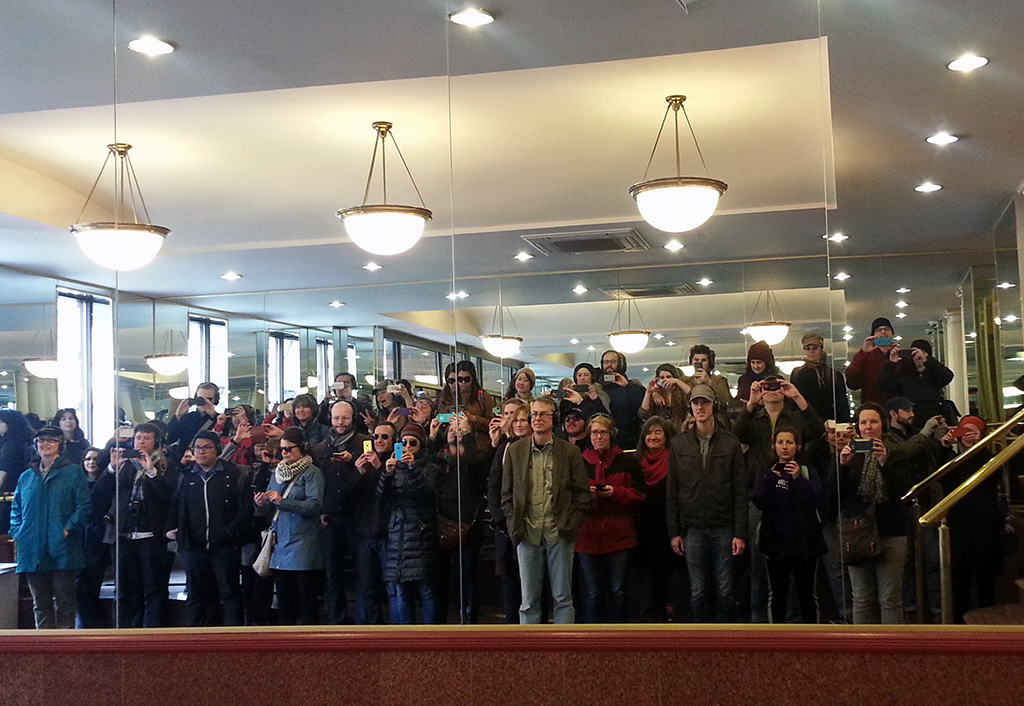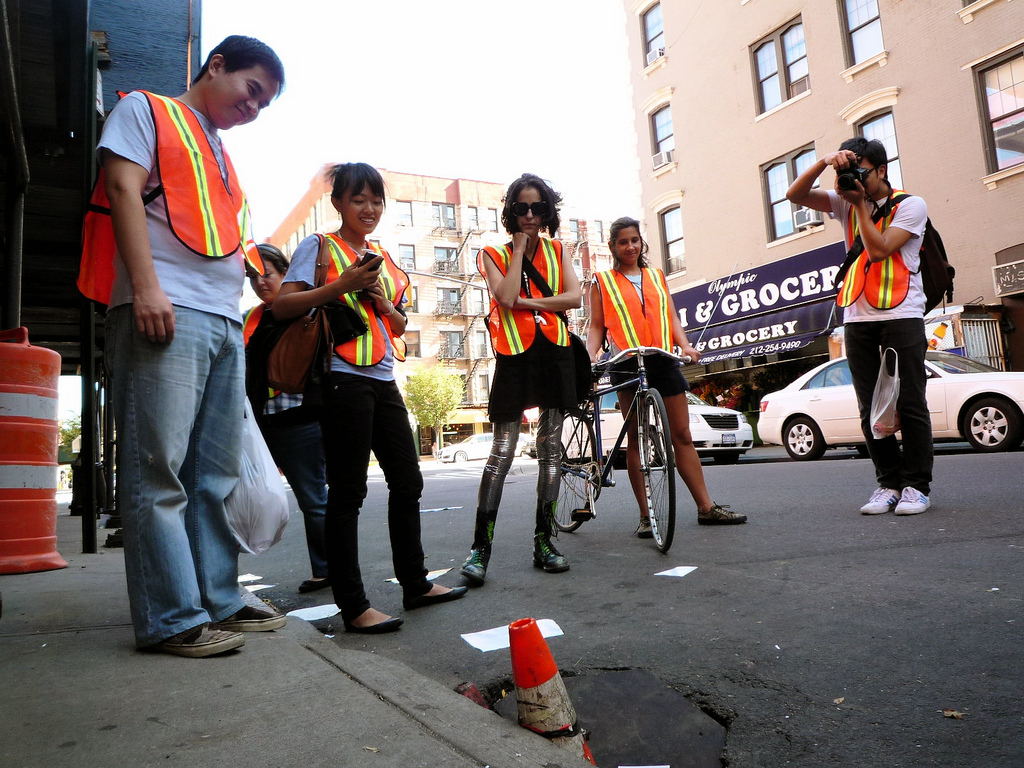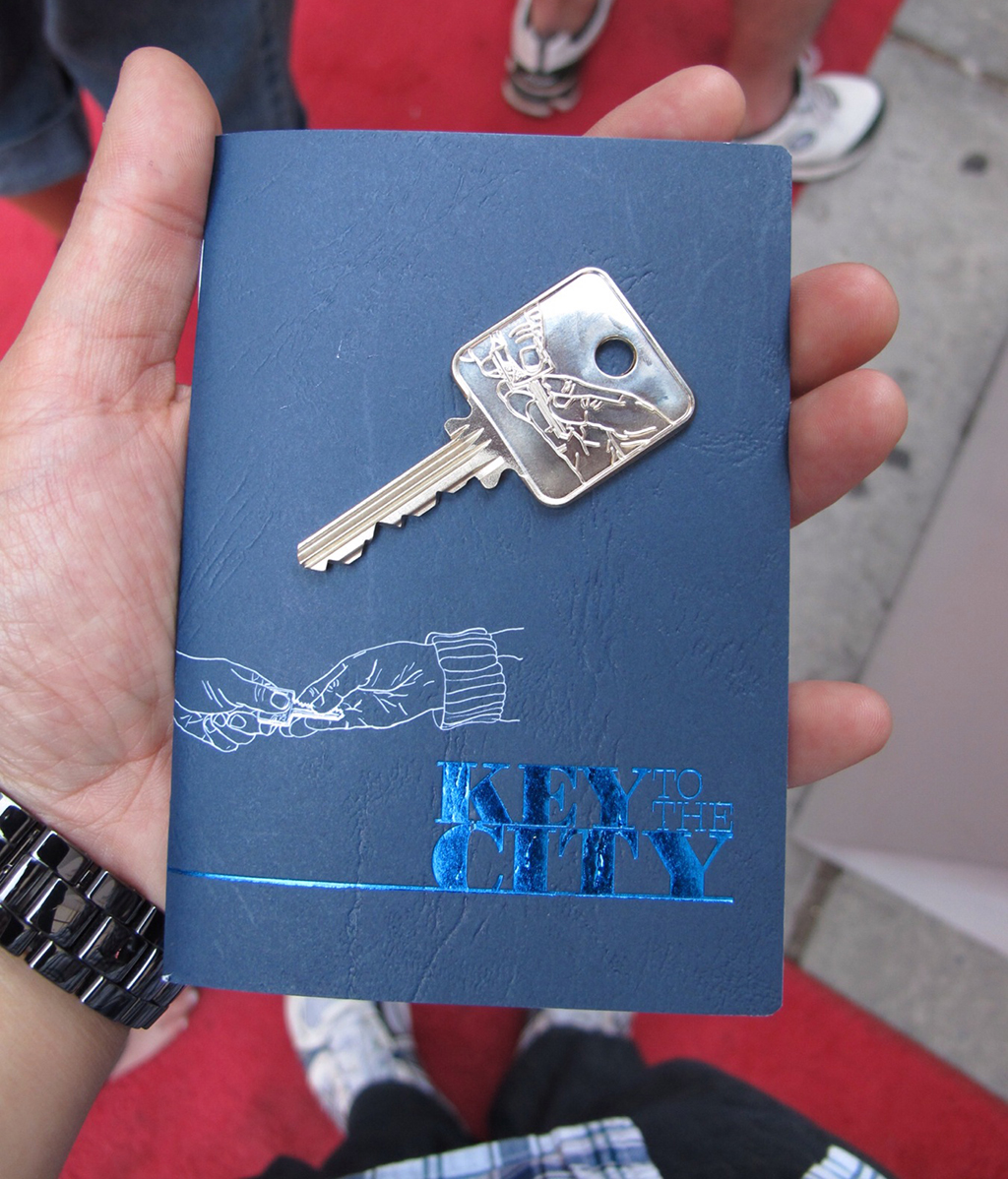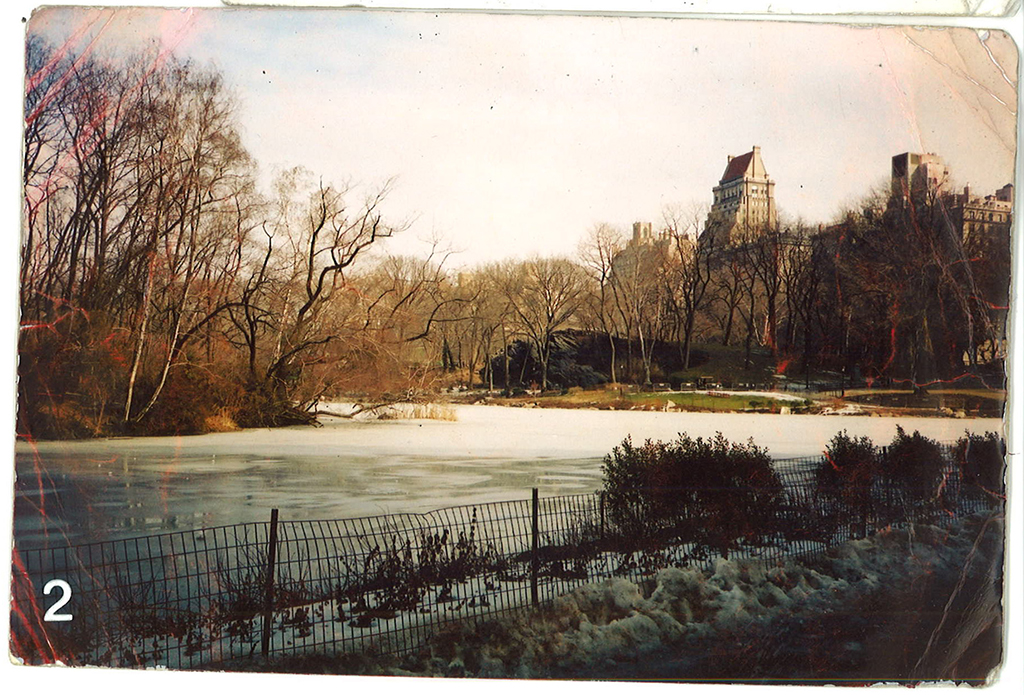
We are celebrating 15 years — and counting — of stories that are deeply researched and deeply felt, that build a historical record of what the city has been.
We are celebrating 15 years — and counting — of stories that are deeply researched and deeply felt, that build a historical record of what the city has been.
“You are a group that does not want to be together; I will call you a horde.”
I am holding hands in a circle of 50 strangers on a blustery spring day in Green-Wood Cemetery. What we share, besides sweaty palms, are identical black headphones cued to the same audio track. We are listening to Heather, a computerized voice with the staccato, metallic intonation of a subway announcer and our guide on a long walk.
Thus began Remote New York, a “pedestrian-based live arts experience” created by the German arts collective Rimini Protokoll. Over the next two hours, Heather leads us from Green-Wood to the subway to Lower Manhattan, where we wend our way to an NYU building in the West Village. Along the way, Heather waxes philosophical on the difference between her, the eternal computer, and us poor, mortal humans. She muses on the ways we give up our agency to technology, a point she easily demonstrates by exhorting the group to tie our shoelaces, jump up and down, race, dance, and mimic a political protest — all to the befuddlement of passersby.
When the walk ended, I felt dazed, as if I had been drugged. It took a few minutes to adjust to walking around without a techno beat or a robotic voice telling me what to do and, by extension, think. Despite this hangover, I found Remote New York to be, on the whole, entertaining and provocative. It seemed that many of my fellow participants enjoyed the experience as well. But as the glow faded, I realized that there was something weird about the project: at no point did it mention anything specific about our setting. I don’t think it named Green-Wood Cemetery or any of its famous residents during the 30 minutes we spent traipsing through. We never heard the name of the subway train we took, on Heather’s direction, into Manhattan. Sara Delano Roosevelt Park, the skinny park in Chinatown we raced in; Elizabeth Street Garden, the sculpture garden in NoLita we danced in; and the streets we walked went totally unmentioned. Instead, Heather guided us with most generic descriptions: “you are standing inside a large cemetery,” “turn left at the stoplight,” “stop at the entrance of the park to your right.” In fact, there was no mention of New York City at any point that I could remember.
As a site-specific practitioner myself, I began to wonder: did it matter that Remote New York was not truly “site-specific”? Would it have been more effective or successful if it prominently featured New York and its uniquities?
These questions seem especially important to ask after two decades in which the field of such projects — including, but not limited to, walking tours, soundwalks, games, narrative experiences, mobile app projects, and theater performances — has exploded. Site-specific work became firmly entrenched in the art world in the 1960s, but this hybrid subset has recently been buoyed by, among other factors, the development of mobile technology and revived interest in (often French) theorists and art collectives that made urban space the center of their philosophical, political, and aesthetic inquiries: Michel de Certeau, Henri Lefebvre, Jane Jacobs, David Harvey, and the Situationists International, to name a few.
In New York alone, festivals, organizations, and events have sprung up in the last decade to accommodate this growing fascination, including Conflux Festival, Art in Odd Places, Come Out and Play, Ideas City, the audio tour company Soundwalk, and artist-walk group Elastic City. (Even Urban Omnibus, which began publishing in 2009, could have been influenced by this trend.) All of these organizations and events helped foster a community of people producing and experiencing site-specific projects in an effort to reclaim, celebrate, educate, and play with and upon New York City’s streets.
While this emerging niche of projects vary greatly in scope, form, and experience, they all tend to share underlying characteristics. First and foremost, to state the obvious: these projects are all designed around, or based upon, a site or sites. These spaces can vary from a private indoor space to a large public one and may feature any number of activities, including walking, game-like interactions, or performances. These projects also tend to emphasize the importance of community, explicitly in the content of the piece or by encouraging engagement among people in groups. Additionally, many of these projects focus on social issues or promote political activism. (It is no coincidence that these characteristics of community and social change also describe socially engaged art, a category that a large number of site-specific projects fall under.) Last but not least, many of these projects use mobile media (smartphones, tablets, and other personal mobile devices) to shape the experience of the participant. Projects can vary from a simple recorded audio piece heard through headphones to videos, GPS services, interactive mobile apps, augmented reality, or all combinations thereof.
One project that encapsulates all these characteristics is Paul Ramirez Jonas’ Key to the City. In this wide-reaching participatory artwork, produced by Creative Time in 2010, interested individuals who visited a kiosk in Times Square were given two “keys to the city,” one of which they could gift to another person. Using a customized mobile app to guide them, these participants could use the key to unlock a private space at 24 sites around New York (including Louis Armstrong’s private bathroom at his house museum in Queens or the basement at a nearby tortilla kitchen). The project, breathtaking in scope, used a simple game-like experience to highlight a larger issue about common space and democratic access to the city. With the symbolic key to the city (an honor usually granted by the mayor to esteemed residents) made physical, participants were allowed to peek into previously hidden or private spaces in areas they may never go otherwise. Implicit is a celebration of community, especially in the energetic power of meeting and connecting with other strangers.
Successful site-specific projects do not, however, need all these characteristics to be considered as such: just look at Janet Cardiff’s seminal 2004 soundwalk Her Long Black Hair. In this piece, participants take a series of short walks around Central Park, listening through headphones to an unnamed melancholy narrator voiced by Cardiff. She ostensibly tells the story of a mysterious 19th-century girl but frequently diverges into musings, observations, soundscapes, and guided experiments, allowing the piece to evolve into a larger meditation on the interplay between memory, sense, and place. The project has no real sense of community — it’s a private dialogue between the narrator and each participant — and does not appear to have any obvious social or political message. And unlike conventional walking tours, which connect the chronology of a place to a larger history, Cardiff’s quiet, poetic, and often abstract musings invoke more of an aesthetic sensibility and sensory experience than a narrative arc.
However, the piece does feature the site. Participants are directed to look at specific sites as they walk around the park: the Lake, a picturesque bridge, a gnarled tree, and a statue. Bits of history (like Frederick Law Olmsted’s design process and John Lennon’s apartment) are occasionally mentioned. Participants are also given historical photographs of several locations, which they are told to hold up as they pass them, visually highlighting the contrast between past and present. Cardiff also uses mobile media effectively to immerse the participant, layering sophisticated binaural recordings of voices and soundscapes over the everyday sounds of the park, creating a powerful juxtaposition between the recording and the ephemeral, shifting experience of an everyday walk. (This experience, one that many audio projects seek to create, can be shocking. It disrupts the expectations of participants, forcing them to pay attention in a way they would never have otherwise. I received a huge jolt when, as I walked around the lake, Cardiff mentioned that a man was walking toward me, touching his face, while at that same moment a real-life man did just that!)
Her Long Black Hair, in many ways, shares a strong resemblance to Remote New York. Both projects are audio walks around New York City featuring recordings as their mobile medium. Both star (fictionalized) female narrators, who not only guide participants but also wax philosophical and, periodically, make demands of their participants to do some crazy things. And, finally, both eschew the form of traditional historical or nature tours for a more disjointed, rambling monologue. Yet Cardiff’s piece seemed richer, deeper, more cohesive and evocative. Why? It all goes back to place. Her Long Black Hair seems to be clearly and deliberately designed to feature Central Park as a major star in her piece. On a physical level, the park’s weaving, curving paths mirror Cardiff’s nonlinear storytelling, while the textured mix of nature and man-made sites along the route serve as jumping-off points for her observations (and the ones she then directs the participant to make). Symbolically, the park’s roles as an iconic tourist site and public gathering space for intimate moments were also plumbed for Cardiff’s narration, and, on a deeper level, served to make metaphorical connections between place, the physical environment, and our collective and individual history.
Remote New York, on the other hand, could have been — and, in fact, was — carried out anywhere. As of spring 2015, Rimini Protokoll had launched the project (which they tellingly refer to as Remote X) in 17 different cities, rescripting it each time only to accommodate practical adjustments based on differentials in travel times and availability of locations. More than anything else, Remote is really about the relationship between technology, humans, and their behavior in public spaces, whether they’re found on the streets of New York, Milan, or even, perhaps, an indoor mall or airport. In that case, why should we expect or desire so much emphasis on place? Aesthetically, one reason is that the project feels hollow and disjointed without it. Other than my visit to the historic Green-Wood Cemetery and long hop over to lower Manhattan, my memory of the route was fuzzy. I have forgotten all the natural connections made between the dramatic moments of narration and the sites in which they occurred. Without this spatial link, my understanding — and excitement for — the larger goals of the project have blurred and faded away. By contrast, Cardiff’s piece, which I experienced in 2012, remains sharply etched in my mind.
But let’s say this generic experience was not just a practicality for wide distribution but a deliberate act on the part of Rimini Protokoll. If so, what was the point? And did it succeed? We can argue that Remote was designed at least in part to critique the walking tour genre, most often defined by its admittedly banal guides and tales. Or maybe it was designed to dredge up the depressing 21st-century realization that all cities, bowed in part by global chains, are starting to look and feel the same. If that’s the case, neither point really came through. The landmarks we passed along Remote’s tour (a busy Chinatown park, the lobby of a nondescript apartment building, the NYU gym) are, other than maybe Green-Wood cemetery, by no means the usual suspects of a standard walking tour. And if the tour was meant to highlight how generic many cities have become, explaining its lack of attention to specific landmarks or locales, no bit of commentary or performance along the tour made that clear.
This close reading of Remote New York boils down to a simple conclusion: yes, site matters. Site-specific projects should incorporate their setting into the themes of the project, if not the content and structure, to be cohesive. This relates, in part, to expectation: if someone creates a project in a setting that normally isn’t used to exhibit art, a reason is called for. Ideally, understanding that reason will help the audience understand that project’s themes. Call it a site-specific version of Chekhov’s gun — the idea that any dramatic element introduced must be incorporated into the story. Furthermore, the power of site in a site-specific project is that it literally grounds the work, making the art’s aesthetic goals actually concrete, whether the project becomes a springboard for a history lesson, a nature experience, or a more intangible and complex aesthetic discussion of place and form.
Remote New York, by these standards, did not fulfill expectations, at least not on the surface. But, as this essay demonstrates, its omission of place — whether deliberate or not — did in fact trigger the very discourse that underlies the most successful site-specific works. If anything, it prompts me to understand my own site-specific practice and commitment to it, and why I take the “site” part of any site-specific work very seriously. I believe that this grounding can also lead to change. If Remote New York’s oddly generic tour inspires its “hordes” to think more about the importance of site, they might be more likely to care about it (and their neighborhood, borough, and city) and to fight to make it a place they want to live in.
The views expressed here are those of the authors only and do not reflect the position of The Architectural League of New York.





